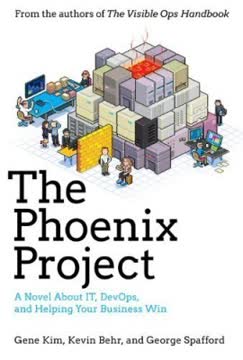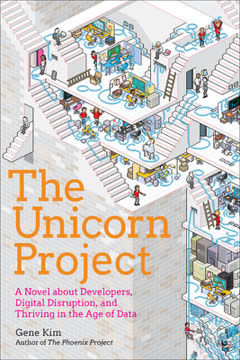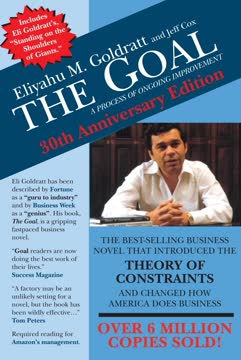Key Takeaways
1. Identify the system's constraint to improve overall performance
"The Goal is about science and education. I believe that these two words have been abused to the extent that their original meanings have been lost in a fog of too much respect and mystery."
The bottleneck principle. In any complex system, there is always one constraint that limits overall performance. This constraint, or bottleneck, determines the throughput of the entire system. By identifying and focusing on this constraint, managers can dramatically improve the performance of their organizations.
Steps to identify constraints:
- Analyze the flow of work through the system
- Look for areas where work consistently piles up
- Measure the capacity of each resource against demand
- Consider both physical and policy constraints
Real-world application: In the novel, Alex Rogo identifies the NCX-10 machine and the heat-treat furnace as the primary bottlenecks in his plant. By focusing on these constraints, he is able to significantly improve the plant's performance and save it from closure.
2. Balance flow, not capacity, to optimize production
"A plant in which everyone is working all the time is very inefficient."
Challenging traditional thinking. The common belief that maximizing the efficiency of every resource leads to optimal performance is flawed. Instead, the focus should be on balancing the flow of work through the entire system.
Key concepts:
- Dependent events: Steps in a process that must occur in a specific order
- Statistical fluctuations: Natural variations in process times and quality
Implications:
- Non-bottleneck resources should not always be working at full capacity
- Excess capacity in non-bottleneck areas is necessary to maintain flow
- Bottleneck resources should be fully utilized to maximize system performance
3. Subordinate everything to the constraint for maximum efficiency
"An hour lost at a bottleneck is an hour lost for the entire system."
Prioritizing the constraint. Once the system's constraint is identified, all other resources and processes should be aligned to support and maximize the efficiency of the constraint.
Practical steps:
- Ensure bottlenecks always have work available
- Implement quality control before the bottleneck to avoid wasting time on defective parts
- Adjust schedules and priorities to keep the bottleneck running
- Reallocate resources to support the bottleneck's operation
Example: In the novel, Alex implements a "red tag" system to prioritize work for the bottleneck resources, ensuring they are never idle due to lack of materials or support.
4. Exploit the constraint to its fullest potential
"Activating a resource and utilizing a resource are not synonymous."
Maximizing bottleneck efficiency. Before investing in additional capacity, ensure that the current constraint is being utilized to its fullest potential.
Strategies for exploitation:
- Eliminate non-productive time (e.g., breaks, setups) at the bottleneck
- Improve the quality of inputs to the bottleneck
- Offload work from the bottleneck to non-bottleneck resources when possible
- Focus on improving the bottleneck's efficiency through training and process improvements
Real-world example: The plant in the novel implements new break schedules and quality control measures to ensure the bottleneck machines are always productive.
5. Elevate the constraint only after other steps are exhausted
"Every time a bottleneck finishes a part, you are making it possible to ship a finished product."
Strategic capacity expansion. After exploiting the current constraint to its fullest, consider investing in additional capacity to elevate the constraint.
Considerations before elevating:
- Ensure all previous steps have been thoroughly implemented
- Analyze the potential impact on the entire system
- Consider alternative solutions (e.g., outsourcing, technology upgrades)
- Evaluate the financial implications of the investment
Caution: Elevating the constraint may shift the bottleneck to another part of the system, requiring a reassessment of the entire process.
6. Beware of inertia: Continuously reassess constraints
"WARNING!!!! If in the previous steps a constraint has been broken, go back to step 1, but do not allow INERTIA to cause a system's constraint."
Ongoing improvement process. As constraints are addressed and resolved, new bottlenecks will emerge. It's crucial to continually reassess and identify new constraints to maintain optimal performance.
Signs of inertia:
- Continuing to focus on old bottlenecks that are no longer constraints
- Maintaining policies or procedures that were designed for previous constraints
- Failing to recognize shifting market demands or competitive pressures
Example: In the novel, Alex realizes that after improving plant efficiency, the market becomes the new constraint, requiring a shift in focus to sales and marketing strategies.
7. Implement the Theory of Constraints (TOC) for ongoing improvement
"A process of ongoing improvement."
Systematic approach to improvement. The Theory of Constraints provides a framework for continuous improvement in organizations by focusing on identifying and addressing constraints.
Five focusing steps of TOC:
- Identify the constraint
- Exploit the constraint
- Subordinate everything else
- Elevate the constraint
- Repeat the process
Benefits of TOC implementation:
- Improved throughput and profitability
- Reduced inventory and operating expenses
- Enhanced problem-solving capabilities
- Increased organizational focus and alignment
8. Challenge traditional cost accounting methods for better decision-making
"Everything I was holding in my files is data. What you are usually asking for is information."
Rethinking financial metrics. Traditional cost accounting methods can lead to suboptimal decisions by focusing on local efficiencies rather than overall system performance.
Problems with traditional accounting:
- Emphasis on cost reduction over throughput increase
- Misallocation of overhead costs
- Encouragement of excess inventory to improve "efficiency" metrics
Alternative metrics to consider:
- Throughput (revenue minus truly variable costs)
- Inventory (money tied up in the system)
- Operating expense (money spent to turn inventory into throughput)
Example: In the novel, Alex challenges the traditional product cost calculations, leading to more profitable pricing and production decisions.
9. Focus on throughput, not just cost reduction, to increase profits
"The goal of a manufacturing organization is to make money."
Shifting focus to revenue generation. While cost reduction is important, increasing throughput (the rate at which the system generates money through sales) often has a more significant impact on profitability.
Strategies to increase throughput:
- Identify and exploit market constraints
- Improve product mix to focus on high-margin items
- Reduce lead times to capture more market share
- Develop new products or services to expand the market
Financial impact: Increasing throughput often has a more substantial effect on the bottom line than equivalent cost reductions, as demonstrated by Alex's success in turning around the plant's performance.
10. Use the Socratic method to drive organizational change
"If I simply told you what to do, ultimately you would fail. You have to gain the understanding for yourself in order to make the rules work."
Fostering critical thinking. The Socratic method of asking probing questions encourages individuals to discover solutions for themselves, leading to deeper understanding and commitment to change.
Benefits of the Socratic approach:
- Encourages critical thinking and problem-solving
- Builds ownership and commitment to solutions
- Challenges assumptions and ingrained beliefs
- Promotes continuous learning and improvement
Application: Throughout the novel, Jonah uses the Socratic method to guide Alex and his team to discover solutions, rather than simply providing answers.
11. Apply scientific thinking to management for sustainable success
"Science for me, and for the vast majority of respectable scientists, is not about the secrets of nature or even about truths. Science is simply the method we use to try and postulate a minimum set of assumptions that can explain, through a straightforward logical derivation, the existence of many phenomena of nature."
Management as a science. Applying scientific thinking to management involves developing hypotheses, testing assumptions, and continuously refining theories based on evidence.
Key elements of scientific management:
- Clearly define problems and objectives
- Develop testable hypotheses
- Gather and analyze data
- Draw logical conclusions
- Implement and monitor solutions
- Continuously refine and improve
Long-term impact: By adopting a scientific approach to management, organizations can develop robust, adaptable strategies that lead to sustainable success in dynamic business environments.
Last updated:
FAQ
What's The Goal by Eliyahu M. Goldratt about?
- Manufacturing Focus: The Goal is a business novel that follows Alex Rogo, a plant manager, as he works to save his manufacturing plant from closure by applying the Theory of Constraints (TOC).
- Theory of Constraints: The book introduces TOC, a management philosophy that emphasizes identifying and managing bottlenecks to improve production efficiency.
- Narrative Style: Goldratt uses a narrative approach to explain complex concepts, making them accessible to readers without a technical background.
- Organizational Goal: The central theme is that the primary goal of any organization, especially in manufacturing, is to make money by increasing throughput and reducing inventory and operational expenses.
Why should I read The Goal by Eliyahu M. Goldratt?
- Practical Insights: The book offers practical insights into improving manufacturing efficiency and productivity, valuable for managers and business leaders.
- Engaging Storytelling: Goldratt's narrative style keeps readers engaged, blending fiction with educational content for a deeper understanding of the concepts.
- Timeless Principles: The principles discussed are applicable across various industries, not just manufacturing, and can improve organizational and personal productivity.
- Foundation for TOC: Reading The Goal provides a foundational understanding of the Theory of Constraints, leading to significant improvements in productivity and profitability.
What are the key takeaways of The Goal by Eliyahu M. Goldratt?
- Theory of Constraints: Every system has at least one constraint that limits its performance; identifying and managing these constraints is crucial for improvement.
- Three Measurements: Goldratt introduces throughput, inventory, and operational expense as critical metrics for assessing manufacturing health.
- Focus on Flow: The book emphasizes balancing flow rather than capacity to manage bottlenecks effectively and meet market demand.
- Continuous Improvement: TOC promotes a cycle of continuous improvement, adapting to changing conditions to enhance performance over time.
What is the Theory of Constraints in The Goal by Eliyahu M. Goldratt?
- Definition: TOC is a management philosophy focusing on the most critical limiting factor (constraint) that hinders achieving a goal, often related to production bottlenecks.
- Five Focusing Steps: TOC involves identifying, exploiting, subordinating, elevating constraints, and repeating the process for continuous improvement.
- Holistic View: It encourages a holistic view of the organization, considering all parts of the system in relation to the constraint to prevent local optimizations that harm overall performance.
How does The Goal by Eliyahu M. Goldratt address the concept of bottlenecks?
- Identification: The book stresses identifying bottlenecks, resources whose capacity is equal to or less than the demand placed upon them.
- Management: Once identified, bottlenecks should be managed to ensure full capacity utilization, possibly by prioritizing work or reallocating resources.
- System Impact: Bottlenecks determine the performance of the entire system; mismanagement can lead to increased inventory and operational expenses, affecting profitability.
What are the three measurements introduced in The Goal by Eliyahu M. Goldratt?
- Throughput: Defined as the rate at which the system generates money through sales, emphasizing the importance of selling products for financial success.
- Inventory: Represents all the money invested in purchasing things intended to sell, highlighting the need to manage inventory levels to avoid excess costs.
- Operational Expense: The total money spent to turn inventory into throughput, crucial for understanding the overall efficiency of the manufacturing process.
What are the best quotes from The Goal by Eliyahu M. Goldratt and what do they mean?
- "The goal of a manufacturing organization is to make money.": Emphasizes that all activities should contribute to financial success, focusing on profitability over efficiency.
- "Throughput is the rate at which the system generates money through sales.": Highlights the importance of sales in measuring productivity, shifting focus from production to sales-driven revenue.
- "You can’t manage what you don’t measure.": Underscores the necessity of clear measurements to assess performance, essential for identifying problems and tracking improvements.
How does The Goal by Eliyahu M. Goldratt illustrate the importance of teamwork?
- Collaboration: Teamwork is essential for overcoming challenges and achieving organizational goals, with characters working together to identify bottlenecks and implement solutions.
- Shared Responsibility: Emphasizes that everyone has a role in achieving the goal, with individual actions impacting overall success.
- Communication and Trust: Effective communication and trust among team members are crucial for implementing changes and addressing issues, leading to a productive work environment.
What challenges does Alex Rogo face in The Goal by Eliyahu M. Goldratt?
- Plant Closure Threat: Alex faces the threat of his plant being shut down due to poor performance, driving him to seek solutions to save the plant and protect jobs.
- Work-Life Balance: He struggles to balance his demanding job with family life, leading to personal conflicts and emotional strain.
- Resistance to Change: Alex encounters resistance from management and employees when implementing new ideas, a significant challenge in shifting the plant's culture.
How can I apply the lessons from The Goal by Eliyahu M. Goldratt to my own work?
- Identify Constraints: Start by identifying constraints in your work processes, such as bottlenecks or inefficiencies, to understand areas for improvement.
- Focus on the Goal: Align actions and decisions with the primary goal of your organization, whether it's making money or improving customer satisfaction.
- Continuous Improvement: Adopt a mindset of continuous improvement, regularly evaluating processes and encouraging collaboration and open communication for a culture of improvement.
How can the concepts in The Goal by Eliyahu M. Goldratt be applied to other industries?
- Universal Principles: TOC principles apply to any industry involving processes and resource management, such as healthcare and supply chain management.
- Process Optimization: Use insights from the book to streamline operations, improve efficiency, and enhance customer satisfaction, leading to increased profitability.
- Cultural Shift: Implementing TOC often requires a cultural shift, encouraging collaboration, continuous improvement, and a focus on overall goals rather than localized efficiencies.
What role does management play in the success of the concepts in The Goal by Eliyahu M. Goldratt?
- Leadership and Vision: Effective management sets a clear vision and direction, communicating the importance of TOC principles and fostering a culture of improvement.
- Empowering Employees: Managers should empower employees to take ownership of their work and contribute to problem-solving efforts, essential for implementing TOC concepts.
- Monitoring and Adapting: Continuous monitoring of performance metrics and adapting strategies as needed ensures responsiveness to changing conditions and sustained improvements.
Review Summary
The Goal received mostly positive reviews for its engaging storytelling approach to teaching business concepts like the Theory of Constraints. Readers praised its practical insights into manufacturing processes, bottlenecks, and optimizing throughput. Many found it eye-opening and applicable beyond just manufacturing. Some criticized the dated gender roles and weak character development. Overall, reviewers appreciated how the novel format made complex ideas accessible, though a few felt the narrative was distracting or boring. The book is considered a classic in operations management literature.
Similar Books










Download PDF
Download EPUB
.epub digital book format is ideal for reading ebooks on phones, tablets, and e-readers.









